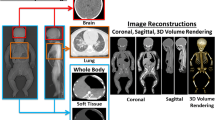Abstract
Background
The use of post-mortem imaging, including skeletal radiography, CT and MRI, is increasing, providing a minimally invasive alternative to conventional autopsy techniques. The development of clinical guidelines and national standards is being encouraged, particularly for cross-sectional techniques.
Objective
To outline the current practice of post-mortem imaging amongst members of the European Society of Paediatric Radiology (ESPR).
Materials and methods
We e-mailed an online questionnaire of current post-mortem service provisions to members of the ESPR in January 2013. The survey included direct questions about what services were offered, the population imaged, current techniques used, imaging protocols, reporting experience and intended future involvement.
Results
Seventy-one percent (47/66) of centres from which surveys were returned reported performing some form of post-mortem imaging in children, of which 81 % perform radiographs, 51% CT and 38% MRI. Eighty-seven percent of the imaging is performed within the radiology or imaging departments, usually by radiographers (75%), and 89% is reported by radiologists, of which 64% is reported by paediatric radiologists. Overall, 72% of positive respondents have a standardised protocol for radiographs, but only 32% have such a protocol for CT and 27% for MRI. Sixty-one percent of respondents wrote that this is an important area that needs to be developed.
Conclusion
Overall, the majority of centres provide some post-mortem imaging service, most of which is performed within an imaging department and reported by a paediatric radiologist. However, the populations imaged as well as the details of the services offered are highly variable among institutions and lack standardisation. We have identified people who would be interested in taking this work forwards.





Similar content being viewed by others
References
Royal College of Pathologists Working Party on the Autopsy (2006) Guidelines on Autopsy Practice: Scenario 9: Stillborn infant (singleton). http://www.rcpath.org/Resources/RCPath/Migrated%20Resources/Documents/G/G001Autopsy-Stillbirths-Jun06.pdf. (Accessed 11 June 2013)
Arthurs OJ, Calder AC, Kiho L et al. (2013) Routine perinatal and paediatric post-mortem radiography: detection rates and implications for practice. Pediatr Radiol. doi:10.1007/s00247-013-2804-0
O’Donoghue K, O’Regan KN, Sheridan CP et al (2012) Investigation of the role of computed tomography as an adjunct to autopsy in the evaluation of stillbirth. Eur J Radiol 81:1667–1675
Thayyil S, Sebire NJ, Chitty LS et al (2013) Post-mortem MRI versus conventional autopsy in fetuses and children: a prospective validation study. Lancet 382(9888):223–33
Rutty G (2012) Can cross-sectional imaging as an adjunct and/or alternative to the invasive autopsy be implemented within the NHS? Report from the NHS Implementation Sub-group of the Department of Health Post Mortem, Forensic and Disaster Imaging Group (PMFDI). http://www2.le.ac.uk/departments/emfpu/national-documents-1 (Accessed 11 June 2013)
Biggs MJ, Brown LJ, Furness PN (2009) Online survey of current autopsy practice. J Clin Pathol 62:525–529
Riccabona M (2012) Application of a second-generation US contrast agent in infants and children – a European questionnaire-based survey. Pediatr Radiol 42:1471–1480
Arthurs OJ, van Rijn R, Sebire NJ (2013) Current status of paediatric post-mortem imaging: an ESPR questionnaire-based survey. Pediatr Radiol 43:S573
The Royal College of Child Health and Paediatrics and the Royal College of Radiologists (2008) Standards for radiological investigations of suspected non-accidental injury. London; RCPCH. Ref BFCR(08)1
American College of Radiology (2006) ACR practice guidelines for skeletal surveys in children. http://www.acr.org/~/media/ACR/Documents/PGTS/guidelines/Skeletal_Surveys.pdf. (Accessed 14 October 2013)
Acknowledgments
O.J.A. is funded by an NIHR Clinician Scientist Fellowship, and N.J.S. is partially supported by the Great Ormond Street Children’s Charity and the Great Ormond Street Hospital Biomedical Research Centre. This article presents independent research funded by the National Institute for Health Research (NIHR) and supported by the Great Ormond Street Hospital Biomedical Research Centre. The views expressed are those of the authors and not necessarily those of the National Health Service, the NIHR or the Department of Health.
We are grateful to the ESPR for allowing us to use their e-mail database to perform this survey, and for the opportunity to present the results at the ESPR 2013 congress in Budapest. We are indebted to the individual participants who took the time to complete the survey.
Conflicts of interest
None
Author information
Authors and Affiliations
Corresponding author
Rights and permissions
About this article
Cite this article
Arthurs, O.J., van Rijn, R.R. & Sebire, N.J. Current status of paediatric post-mortem imaging: an ESPR questionnaire-based survey. Pediatr Radiol 44, 244–251 (2014). https://doi.org/10.1007/s00247-013-2827-6
Received:
Revised:
Accepted:
Published:
Issue Date:
DOI: https://doi.org/10.1007/s00247-013-2827-6




